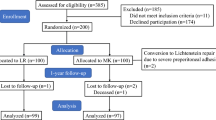Abstract
Purpose
The transinguinal preperitoneal approach is a relatively new technique for inguinal hernia repair. Two types of memory-ring mesh are available in Japan: the modified Kugel patch (MK) and the Polysoft patch (PP). We tested the hypothesis that the PP is noninferior to the MK with respect to chronic postoperative pain.
Methods
An unblinded randomized controlled trial was conducted to assess the noninferiority of PP compared to MK with a 5 % noninferiority margin. A total of 442 inguinal hernia patients operated on from November 2010 to December 2012 were included in this study. The primary endpoint was the pain score assessed by the visual analog scale (VAS) (0–1 vs. 2–10) 1 year after surgery.
Results
The patients were randomized to the PP and MK groups (n = 221 each). One year after surgery, 206 patients (95.4 %) in the PP group and 182 patients (89.6 %) in the MK group rated pain at 0–1 on the VAS scale. According to this rating, the PP group appeared not to be inferior to the MK group (95 % confidence interval, 0.7–10.7 %, P < 0.05). Furthermore, crude superiority tests, adjusting for 1 month of pain, denoted that the outcomes were significantly improved with the PP compared to the MK.
Conclusions
The use of the PP was noninferior to the MK with respect to the severity of postoperative chronic pain scores 12 months after surgery.


Similar content being viewed by others
References
Aasvang E, Kehlet H. Chronic postoperative pain: the case of inguinal herniorrhaphy. Br J Anaesth. 2005;95:69–76.
Kehlet H, Roumen RM, Reinpold W, Miserez M. Invited commentary: persistent pain after inguinal hernia repair: what do we know and what do we need to know? Hernia. 2013;17:293–7.
Dennis R, O’Riordan D. Risk factors for chronic pain after inguinal hernia repair. Ann R Coll Surg Engl. 2007;89:218–20.
Hakeem A, Shanmugam V. Current trends in the diagnosis and management of post-herniorrhaphy chronic pain. World J Gastrointest Surg. 2011;3:73–81.
Pelissier EP. Inguinal hernia:preperitoneal placement of a memory-ring patch be anterior approach. Preliminary experience. Hernia. 2006;2006(10):248–52.
Berrevoet F, Sommeling C, De Gendt S, Breusegem C, de Hemptinne B. The preperitoneal memory-ring patch for inguinal hernia: a prospective multicentric feasibility study. Hernia. 2009;13:243–9.
Malliart JF, Vantournhoudt P, Piret-Garard G, Farghadani H, Mauel E. Transinguinal preperitoneal groin hernia repair using a preperitoneal mesh preformed with a permanent memory ring: a good alternative to Lichtenstein’s technique. Hernia. 2011;15:289–95.
Chen DC, Amid PK. Chronic pain and quality of life after transinguinal preperitoneal (TIPP) inguinal hernia repair: a few tips on TIPP. Hernia. 2013;17:693–5.
Suwa K, Nakajima S, Hanyu K, Suzuki T, Okamoto T, Yanaga K. Modified Kugel herniorrhaphy using standardized dissection technique of the preperitoneal space long-term operative outcome in consecutive 340 patients with inguinal hernia. Hernia. 2013;17:699–707.
Berrevoet F, Maes L, Reybtjens K, Rogiers X, Troisi R. Hemptinne. Transinguinal preperitoneal memory ring patch versus Lichtenstein repair for unilateral inguinal hernias. Langenbecks Arch Surg. 2010;395:557–62.
Gillion J-F, Chollet J-M. Chronic pain and quality of life (QoL) after transinguinal preperitoneal (TIPP) inguinal hernia repair using a totally extraperitoneal, parietalized, Polysoft memory ring patch. Hernia. 2013;17:683–92.
Inaba T, Okinaga K, Fukushima R, Ikeda Y, Yamazaki E, Koide T, Horikawa M, Inoue T, Ogawa E. Chroic pain and discomfort after inguinal hernia repair. Surg Today. 2012;42:825–9.
Hirose T, Takayama Y, Komatsu S, Shingu Y, Sakamoto E, Norimizu S, Hasegawa H. Randomized clinical trial comparing lightweight or heavyweight mesh for mesh plug repair of primary inguinal hernia. Hernia. 2014;18:213–9.
van Veen RN, Wijsmuller AR, Vrijland WW, et al. Long-term follow up of a randomized clinical trial of non-mesh versus mesh repair of primary inguinal hernia. Br J Med. 2007;94:506–10.
Yanagawa T, Tango T, Hiejima Y. Mantel-Haenszel type test for testing equivalence or more than equivalence in comparative clinical trials. Biometrics. 1994;50:859–64.
Schulz KF, Altman DG, Moher D, The CONSORT Group. CONSORT 2010 statement: updated guidelines for reporting parallel group randomized trials. BMJ. 2010;340:c332.
Erhan Y, Erhan E, Aydede H, Mercan M, Dermet T. Chronic pain after Lichtenstein and preperitoneal (posterior) hernia repair. Can J Surg. 2008;51:383–7.
Hayashi Y, Miyata K, Yuasa N, Takeuchi E, Goto Y, Miyake H, Nagai H, Kobayashi Y. Short- and long-term outcomes of open inguinal repair: comparison of the Prolene Hernia system and the mesh plug method. Surg Today. 2014;44:2255–62.
Wakasugi M, Masuzawa T, Tei M, Omori T, Ueshima S, Tori M, Akamatsu H. Single-incision totally extraperitoneal inguinal hernia repair: our initial 100 cases and comparison with conventional three-port laparoscopic totally extraperitoneal inguinal hernia repair. Surg Today. 2015;45:606–10.
Koning GG, Koole D, de Jonah MAC, de Schipper JP, Verhofstad MHJ, Oostvogel HJM, Vriens PWHE. The transinguinal preperitoneal hernia correction vs Lichtenstein’s technique; is TIIPP top? Hernia. 2011;15:19–22.
Li J, Zhang Y, Hu H, Tang W. Early experience of performing a modified Kugel hernia repair with local anesthesia. Surg Today. 2008;38:603–8.
Uzzman MM, Ratnashingham K, Ashraf N. Meta-analysis of randomized trials comparing lightweight and heavyweight mesh for Lichtenstein inguinal hernia repair. Hernia. 2012;16:505–18.
Kenary AY, Afshin SN, Amoli HA, Notash AY, Borjian A, Notash AY Jr. Randomized clinical trial comparing lightweight mesh with heavyweight mesh for primary hernia repair. Hernia. 2013;17:471–7.
Nikkolo C, Murruste M, Vaasna T, Seepter H, Tikk T, Lepner U. Three year results of randomized clinical trial comparing lightweight mesh with heavyweight mesh for inguinal hernioplasty. Hernia. 2012;16:555–9.
Author information
Authors and Affiliations
Corresponding author
Ethics declarations
Conflict of interest
The authors declare that they have no conflicts of interest in association with this study.
Rights and permissions
About this article
Cite this article
Okinaga, K., Hori, T., Inaba, T. et al. A randomized clinical study on postoperative pain comparing the Polysoft patch to the modified Kugel patch for transinguinal preperitoneal inguinal hernia repair. Surg Today 46, 691–698 (2016). https://doi.org/10.1007/s00595-015-1228-x
Received:
Accepted:
Published:
Issue Date:
DOI: https://doi.org/10.1007/s00595-015-1228-x




